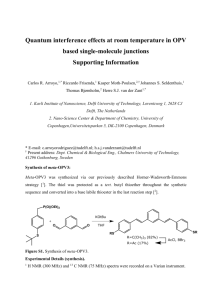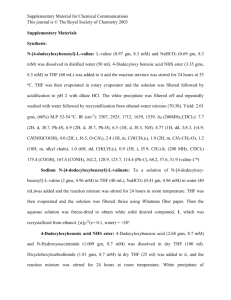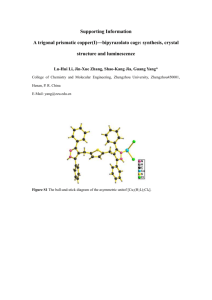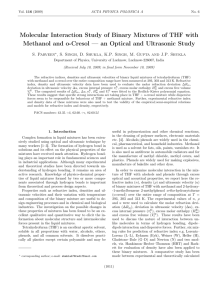Synthetic procedures
advertisement
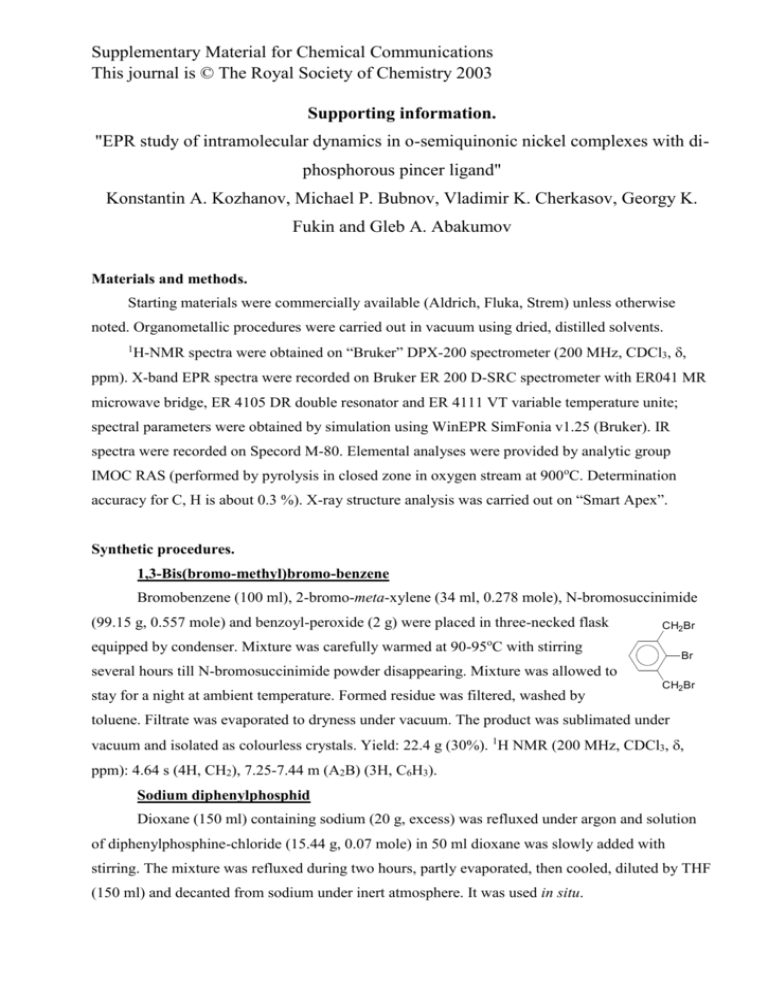
Supplementary Material for Chemical Communications This journal is © The Royal Society of Chemistry 2003 Supporting information. "EPR study of intramolecular dynamics in o-semiquinonic nickel complexes with diphosphorous pincer ligand" Konstantin A. Kozhanov, Michael P. Bubnov, Vladimir K. Cherkasov, Georgy K. Fukin and Gleb A. Abakumov Materials and methods. Starting materials were commercially available (Aldrich, Fluka, Strem) unless otherwise noted. Organometallic procedures were carried out in vacuum using dried, distilled solvents. 1 H-NMR spectra were obtained on “Bruker” DPX-200 spectrometer (200 MHz, CDCl3, , ppm). X-band EPR spectra were recorded on Bruker ER 200 D-SRC spectrometer with ER041 MR microwave bridge, ER 4105 DR double resonator and ER 4111 VT variable temperature unite; spectral parameters were obtained by simulation using WinEPR SimFonia v1.25 (Bruker). IR spectra were recorded on Specord M-80. Elemental analyses were provided by analytic group IMOC RAS (performed by pyrolysis in closed zone in oxygen stream at 900oC. Determination accuracy for C, H is about 0.3 %). X-ray structure analysis was carried out on “Smart Apex”. Synthetic procedures. 1,3-Bis(bromo-methyl)bromo-benzene Bromobenzene (100 ml), 2-bromo-meta-xylene (34 ml, 0.278 mole), N-bromosuccinimide (99.15 g, 0.557 mole) and benzoyl-peroxide (2 g) were placed in three-necked flask CH2Br o equipped by condenser. Mixture was carefully warmed at 90-95 C with stirring Br several hours till N-bromosuccinimide powder disappearing. Mixture was allowed to stay for a night at ambient temperature. Formed residue was filtered, washed by CH2Br toluene. Filtrate was evaporated to dryness under vacuum. The product was sublimated under vacuum and isolated as colourless crystals. Yield: 22.4 g (30%). 1H NMR (200 MHz, CDCl3, , ppm): 4.64 s (4H, CH2), 7.25-7.44 m (A2B) (3H, C6H3). Sodium diphenylphosphid Dioxane (150 ml) containing sodium (20 g, excess) was refluxed under argon and solution of diphenylphosphine-chloride (15.44 g, 0.07 mole) in 50 ml dioxane was slowly added with stirring. The mixture was refluxed during two hours, partly evaporated, then cooled, diluted by THF (150 ml) and decanted from sodium under inert atmosphere. It was used in situ. Supplementary Material for Chemical Communications This journal is © The Royal Society of Chemistry 2003 1,3-Bis(diphenylphosphinomethyl)bromo-benzene 1,3-Bis(bromo-methyl)bromo-benzene (12 g, 0.035 mole) in 70 ml THF was added to frozen solution of sodium diphenylphosphide (obtained from 15.44 g (0.07 mole) CH2PPh2 diphenylphosphine-chloride) in THF under argon. Reaction mixture was carefully Br warmed to approx. –30 C (acetone bath) and stirred for two hours. Then mixture o CH2PPh2 was allowed to stay at ambient temperature and diluted by water. Precipitate was filtered, dried and recrystallized from toluene. Yield: 8.27 g (43%). 1H NMR (200 MHz, CDCl3, , ppm): 3.60 s (4H, CH2-P); 6.53-6.72 m (AB2) (3H, C6H3); 7.3-7.5 m (20H, -PPh2). 31P NMR (CDCl3, , ppm): -12.15. 1,3-Bis(diphenylphosphino-methyl)phenyl-bromo-nickel Nickel tetracarbonyl (0.335 g, 1.957 mmole) was condensed to frozen solution of 1,3bis(diphenylphosphino-methyl)bromo-benzene in 50 ml of toluene. Mixture was allowed to warm up to ambient temperature. Warming, followed by gas elimination. After the end of gas elimination solution was heated in water bath. Solution colour changed from pale-yellow to red-brown and yellow Ph Ph CH2P NiBr precipitate formed. After the end of gas elimination mixture was cooled and o CH2P m Ph filtered. Yellow solid was recrystallized from THF. Yield: 0.493 g (45%). p o m Anal.(%) Found: C 62.52; H 4.43; Ni 9.75; P 10.26; Br 1387. C32H27P2BrNi Calc.: C 62.75; H 4.41; Ni 9.64; P 10.13; Br 13.07. IR (Nujol, cm-1): 1470s, 1440s, 1425w, 1410w, 1385s, 1315w, 1185w, 1105m, 1070w, 1030w, 1000w, 965w, 845m, 830w, 780w, 755ср, 745m, 710w, 695s, 590w, 530w, 510m, 485w, 445w. 1H NMR (200 MHz, CDCl3, , ppm): 3.83 s (4H, -CH2-P); 7.4 m (12H, o-, pHarom.) и 7.8 m (8H, m-Harom.) – Ph; 7.0 m (3H, -,-Harom.). Thallium 3,5-di-tert-butyl-o-benzosemiquinolate Solution of 3,5-di-tert-butyl-o-benzoquinone (0.5 eq.) in THF was shaken up with excess of thallium amalgam until colour finished changing. Orange suspension of dithallium catechol salt was decanted, amalgam was washed by THF, and suspension was added to 0.5 eq. of 3,5-di-tert-butyl-obenzoquinone giving intensive blue solution of semiquinolate, which was used in situ. Thallium 3,6-di-tert-butyl-o-benzosemiquinolate Synthesis was carried out as described above, but using 3,6-di-tert-butyl-o-benzoquinone. 1,3-Bis(diphenylphosphino-methyl)phenyl-nickel 3,6-di-tert-butyl-o-benzosemiquinolate To solution of 1,3-bis(diphenylphosphino-methyl)phenyl-bromo-nickel (0.1184 g, 0.1927 mmole) in THF (20 ml) the solution of thallium 3,6-di-tert-butyl-o-semiquinolate, obtained from 0.0424 g (0.1927 mmol) of quinone, was added. Resulting brown solution was filtered and Supplementary Material for Chemical Communications This journal is © The Royal Society of Chemistry 2003 concentrated to about 10 ml, and then equal volume of hexane was added. Forming greenish-brown crystals was filtered out, washed with cold hexane and dried in vacuum. IR (Nujol, cm-1): 1545w, 1580w, 1470s, 1440s, 1425m, 1410w, 1385s, 1370m, 1330m, 1280w, 1250w, 1185w, 1105m, 1005w, 975w, 965w, 955w, 850w, 845w, 825w, 750m, 740m, 700s, 660w, 600w, 525w, 525w, 510w, 500w, 485w, 455w. Anal.(%) (1) Found: C 62.52; H 4.43; Ni 9.75; P 10.26; Br 1387. C32H27P2BrNi Calc.: C 62.75; H 4.41; Ni 9.64; P 10.13; Br 13.07. 1,3-Bis(diphenylphosphino-methyl)phenyl-nickel 3,5-di-tert-butyl-o-benzosemiquinolate To solution of 1,3-bis(diphenylphosphino-methyl)phenyl-bromo-nickel (0.1184 g, 0.1927 mmole) in THF (20 ml) the solution of thallium 3,5-di-tert-butyl-o-semiquinolate, obtained from 0.0424 g (0.1927 mmol) of quinone, was added. Resulting brown solution was filtered and evaporated to dryness. Dark residue was dissolved in minimal volume of dichloromethane, then fivefold volume of hexane was added and solution was kept for 5 days. Brown powder was filtered out, washed by hexane and dried in vacuum.
